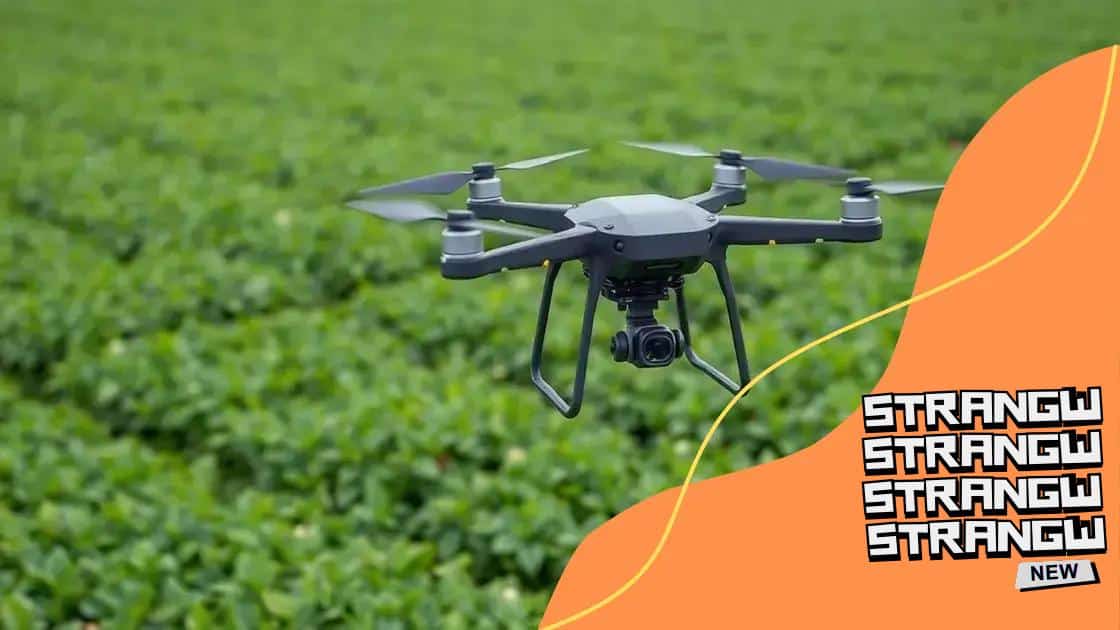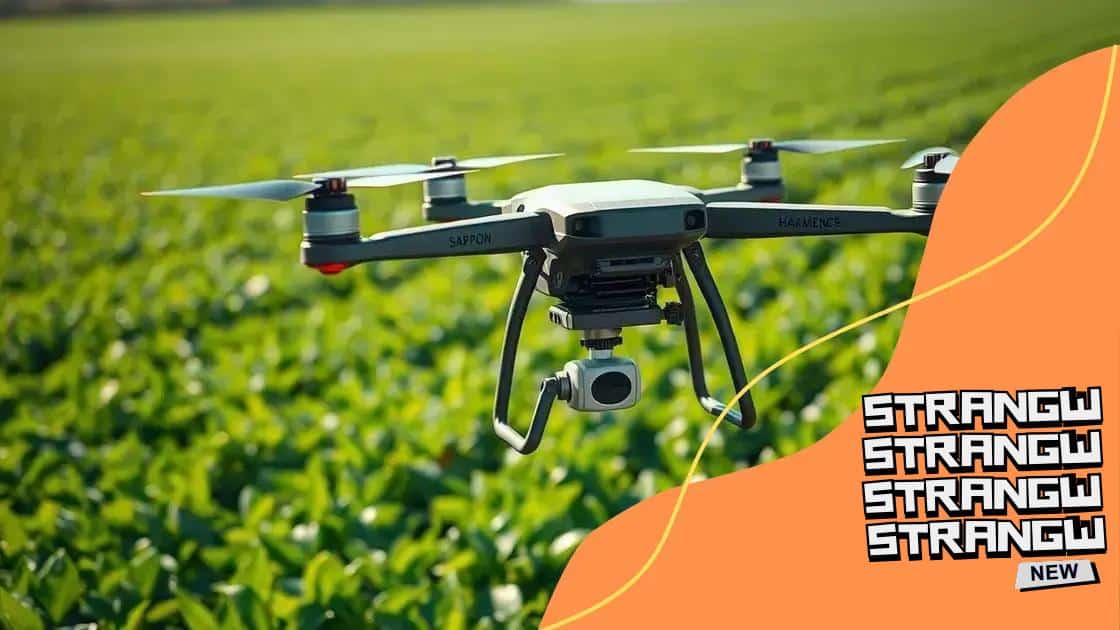Drone technology in agriculture monitoring: the future of farming

Drone technology in agriculture monitoring enhances efficiency by providing real-time data and high-resolution imagery, allowing farmers to make informed decisions that improve crop management and sustainability.
Drone technology in agriculture monitoring is changing the way farmers manage their fields. By leveraging aerial data, farmers can monitor crop health and optimize resources, leading to increased yields and sustainability. Are you curious how this innovation affects farming?
Understanding drone technology in agriculture
Understanding drone technology in agriculture can help farmers improve their productivity. Drones are revolutionizing how we monitor crops and manage land. Using advanced sensors and cameras, drones gather vital data that can enhance farming practices.
How Drones Work in Agriculture
Drones operate by flying over fields and capturing images or data in real-time. This information can be processed to give insights into crop health and soil conditions. Farmers can then make informed decisions based on this data.
Benefits of Using Drones
- Enhanced crop monitoring
- Efficient pesticide application
- Improved yield predictions
- Saves time and reduces costs
One of the key advantages of drones is efficiency. Traditional methods of monitoring crops can be time-consuming and labor-intensive. With drones, farmers can cover large areas in much less time. This not only saves labor but also allows for quick adjustments in farming strategies.
Additionally, drones can provide data that is hard to collect through conventional means. For example, they can identify areas of a field suffering from disease or pest infestations. By addressing these issues immediately, farmers can improve their overall yield.
How Drones Collect Data
Drones are equipped with various sensors and cameras. These tools can capture high-resolution images and data on soil moisture, crop health, and more. This data can be analyzed using software to reveal patterns and trends.
The ability to map fields accurately is another benefit of drone technology. Farmers can create detailed maps that show crop growth stages and identify sections that require attention. This targeted approach helps in making better agricultural decisions, ultimately leading to a more sustainable farming practice.
In conclusion, understanding drone technology in agriculture opens the door to innovative solutions that enhance the way we farm. By utilizing this technology, farmers can boost their efficiency and improve their yields, ensuring a more productive future.
Benefits of drones for crop monitoring
When we talk about the benefits of drones for crop monitoring, it’s clear that these devices are changing the landscape of agriculture. Drones provide farmers with an efficient way to monitor their crops, gaining insights that were previously difficult to obtain.
Key Advantages of Drones
One important advantage is the ability to collect data quickly. Drones can cover vast fields in a short amount of time, capturing detailed images that reveal the health of crops. This speed allows farmers to react promptly to issues like pests or diseases.
- Real-time data collection
- Cost-effective monitoring
- Enhanced precision farming
- Lower environmental impact
Using drones also promotes precision agriculture. By providing accurate information on crop health, farmers can apply fertilizers and pesticides only where needed. This not only saves money but also reduces the environmental impact of farming.
Drones are also capable of providing aerial imagery that helps in assessing crop conditions over time. With these images, farmers can track growth progress and identify problem areas much sooner than traditional methods allow.
Improved Decision Making
Having access to drone data enables farmers to make better decisions regarding their crops. For instance, they can identify underperforming areas and make adjustments to watering or nutrient applications. This proactive approach leads to healthier crops and increased yields.
Additionally, drones can be programmed to operate autonomously, meaning they can perform regular monitoring tasks without much human intervention. This capability frees up time for farmers, allowing them to focus on other essential tasks on the farm.
Overall, the numerous benefits of using drones for crop monitoring not only lead to increased efficiency but also contribute to a more sustainable agricultural future. Embracing this technology can significantly enhance farming practices and productivity.
How drones collect agricultural data

Understanding how drones collect agricultural data is crucial for modern farming. These flying devices utilize advanced technology to gather information that helps farmers make informed decisions about their crops.
Types of Sensors Used
Drones are equipped with various sensors that serve different purposes. For instance, multispectral sensors capture data across multiple wavelengths. This data helps farmers evaluate plant health by detecting differences in color and vitality.
- Multispectral sensors for crop health
- Thermal cameras for temperature readings
- LiDAR systems for detailed topographical mapping
- RGB cameras for high-resolution imagery
Each type of sensor provides unique insights. A thermal camera, for example, can identify areas of water stress in plants. By analyzing the temperature differences, farmers can act quickly to address potential issues.
Data Processing Techniques
Once the data is collected, it needs to be processed to be useful. Drones send the information to software platforms that analyze it and generate detailed reports. These reports can include data on crop health, soil conditions, and areas needing attention.
Farmers can visualize this data through maps and charts, which makes it easier to identify trends and make decisions. The ability to track changes over time is particularly valuable. It allows farmers to see how their crops respond to different management practices.
Furthermore, drones enable precision farming by allowing for targeted interventions based on data. This ensures that inputs like water, fertilizers, and pesticides are applied only where needed. This method not only saves resources but also supports sustainable farming practices.
In summary, the combination of advanced sensors and effective data processing makes drones a powerful tool for collecting vital agricultural data. This technology enables farmers to boost productivity while minimizing waste, leading to better crop management.
Impact of drone technology on farming efficiency
The impact of drone technology on farming efficiency is significant and far-reaching. As farmers adopt this technology, they are finding it easier to manage their operations and improve productivity. Drones offer a way to collect data quickly, allowing for timely decisions that enhance crop yield.
Time Savings
One of the primary benefits is the time saved in monitoring crops. Drones can cover large areas in minutes, providing insights that would take a team of workers hours or days to gather. This efficiency not only frees up labor but also allows farmers to focus on other important tasks.
- Quick field assessments
- Fast identification of problem areas
- Reduction in manual labor
- Better resource allocation
Drones enable farmers to conduct field assessments quickly, allowing for rapid responses to issues like pest infestations or diseases. Early detection means farmers can take action before these problems impact their yield.
Cost Efficiency
Additionally, drone technology can lead to significant cost savings. By using data to target the application of water, fertilizers, and pesticides, farmers can reduce waste and cut unnecessary expenses. This precision agriculture approach maximizes resource use, ensuring that every dollar spent goes further.
Moreover, farmers equipped with drone technology can monitor their crops more regularly without relying on external services. This self-sufficiency can further reduce costs associated with crop management. By embracing these tools, farmers are paving the way for a more effective agricultural practice.
The data collected by drones also supports better decision-making. With more accurate information about soil conditions and crop health, farmers can make adjustments that enhance productivity. This targeted approach contributes directly to higher yields and improved farming efficiency.
Future trends in agriculture with drone technology
The future trends in agriculture with drone technology show great promise for transforming farming practices. As technology evolves, drones are becoming more sophisticated, providing farmers with powerful tools for managing their crops.
Increased Automation
One major trend is the rise of automation in farming. Drones are being designed to perform tasks autonomously, such as monitoring fields and applying nutrients. This automation helps save time and reduce labor costs.
- Automated crop spraying
- Self-flying mass data collection
- Integration with farm management software
- Enhanced decision-making through AI analysis
As drones continue to integrate with other technologies, such as artificial intelligence (AI) and the Internet of Things (IoT), their potential will expand. For instance, AI can be used to analyze data collected by drones, predicting crop yields and identifying potential pests.
Data-Driven Agriculture
Another important trend is the shift towards data-driven agriculture. Drones are not just for aerial photography anymore; they provide valuable insights that help farmers make informed decisions. With accurate data on soil conditions and crop health, farmers can optimize their inputs.
This data allows for precision farming techniques, where resources are allocated more efficiently. By using drones to monitor crops regularly, farmers can adjust their practices and respond to issues as they arise, leading to better overall productivity.
Moreover, the ability to analyze collected data continuously will lead to more sustainable farming practices. Farmers will be able to track their progress over time, ensuring that they minimize waste and maintain healthy crops.
In the coming years, we can also expect advancements in drone technology that enhance their functionality. New sensors and improved battery life will enable longer flights and more accurate data collection, making drones indispensable tools in modern agriculture.
FAQ – Frequently Asked Questions about Drone Technology in Agriculture
How can drones improve crop monitoring?
Drones provide real-time data and high-resolution images, allowing farmers to assess crop health quickly and make informed decisions.
What are the cost benefits of using drones in farming?
Using drones can reduce labor costs, optimize resource use, and lower expenses on inputs like fertilizers and pesticides.
Can drones be used for tasks beyond monitoring?
Yes, drones can be used for tasks such as spraying pesticides, surveying land, and conducting soil analysis.
What future trends can we expect from drone technology in agriculture?
We can expect advancements like increased automation, better data analysis through AI, and integration with other smart farming technologies.





